Ing’s Peace Poem Translated into Sinhalese
Ing’s Peace Poem “Peace Come to You”
Translated into Sinhalese by Ari Vinada, April 2014
Hi Ing,
I have a new translation of your peace poem for you. This one is in Sinhalese, the dominant language of Sri Lanka. It was done by Ari Vidana.. His name is signed at the end in both English and Sinhalese.
It appears it doesn’t follow the structure of how your poem was originally written with “Peace comes to you” as a seperate line, but instead is attached to the previous line. He assures me it is an accurate translation however. Anyway it’s all I’ve got.
Hope all is well with you and John and I apologize for missing his reading a couple weeks back but I just couldn’t made it.
All the best,
Bill
Hi Bill,
Thank you so much for helping me to produce another unique translation of my Peace Poem into Sinhalese language of Sri Lanka.
Some people recommended that I use the internet translation to translate my peace poem in any languages. I have tried to do so but I do not like it, because the machine does not respond to me or have any feeling toward my poem. The idea of asking people to translate for me is to get people to react about the idea of spending time to think about peace. We are all busy with all kinds of work for survival and other things in life, especially in USA. So when people spend time to read or translate my poem, it is so special and a privilege for me. Please thank Mr. Ari Vidana for me, I appreciate his spending time to translate my peace poem.
John and I are fine just busy with our works. We hope you are ok. John will have another play reading at Dixon place on June 11. It will be nice to see you at John’s reading. Please do not worry if you cannot make it.
I just started a Blog Page on my website. Please take a look when you have time. I will email you after I post Sinhalese language of Sri Lanka, the translation from Ari Vidana on my Blog Page.
Please enjoy the spring. Pretty soon we will see green leaves and beautiful colorful flowers. John said he is greeting you with warmer weather and a beautiful spring.
All the best,
Ing
4.10.2014
Sinhala language
From Wikipedia, the free encyclopedia
 Sinhala (????? si?hala [?si???l?]), also known as Sinhalese /s?n??li?z/,[2] is the native language of the Sinhalese people, who make up the largest ethnic group in Sri Lanka, numbering about 16 million. Sinhala is also spoken, as a second language by other ethnic groups in Sri Lanka, totalling about 3 million.[3] It belongs to the Indo-Aryan branch of the Indo-European languages. Sinhala is one of the official and national languages of Sri Lanka. Sinhala, along with Pali, played a major role in the development of Theravada Buddhist literature.
Sinhala (????? si?hala [?si???l?]), also known as Sinhalese /s?n??li?z/,[2] is the native language of the Sinhalese people, who make up the largest ethnic group in Sri Lanka, numbering about 16 million. Sinhala is also spoken, as a second language by other ethnic groups in Sri Lanka, totalling about 3 million.[3] It belongs to the Indo-Aryan branch of the Indo-European languages. Sinhala is one of the official and national languages of Sri Lanka. Sinhala, along with Pali, played a major role in the development of Theravada Buddhist literature.
Sinhala has its own writing system, the Sinhala alphabet, which is a member of the Brahmic family of scripts, and a descendant of the ancient Indian Brahmi script.
The oldest Sinhala Prakrit inscriptions found are from the 3rd to 2nd century BCE following the arrival of Bhuddhism in Sri Lanka,[4] the oldest existing literary works date from the 9th century CE.
The closest relative of Sinhala is the language of the Maldives and Minicoy Island (India), Dhivehi.
Etymology
Sinhala (Si?h?la) is a Sanskrit term; the corresponding Middle Indic word is S?hala; the actual Sinhala term is he?a or (h)e?u. The Sanskrit and the Middle Indic words have as their first element (si?ha and s?ha) the word “lion” in the respective languages.[5] According to legend, Sinhabahu or S?hab?hu (“Lion-arms”), was the son of a Vanga princess and a lion. He killed his father and became king of Vanga. His son Vijaya would emigrate from north India to Lank? and become the progenitor of the Sinhala people. Taking into account linguistic and mythological evidence, we can assume that the first element of the name of the people means “lion”.[6]
As for the second element la, local tradition connects it to the Sanskrit root l?- “to seize”,[7] as to translate it “lion-seizer” or “lion-killer”, or to Sanskrit loha/Sinhala l? “blood”, to have it mean “lion blood”. From a linguistic point of view, however, neither interpretation is convincing, so that we can only safely say that the word Sinhala is somehow connected to a term meaning “lion”.
History
According to the chronicle Mahavamsa, written in Pali, Prince Vijaya and his entourage merged with the native tribes known as Yakkha and Naga. In the following centuries, there was substantial immigration from Eastern India (Kalinga, Magadha)[8] which led to an admixture of features of Eastern Prakrits.[citation needed]
Stages of historical development
The development of the Sinhala language is divided into four periods:
- Sinhala Prakrit (until 3rd century CE)
- Proto-Sinhala (3rd – 7th century CE)
- Medieval Sinhala (7th – 12th century CE)
- Modern Sinhala (12th century – present)
Phonetic development
The most important phonetic developments of the Sinhala language include
- the loss of the aspiration distinction in plosives (e.g. kanav? “to eat” corresponds to Sanskrit kh?dati, Hindi kh?n?)
- the shortening of all long vowels (compare example above) Long vowels in the modern language are due to borrowings (e.g. vib?gaya “exam” < Sanskrit vibh?ga) and sandhi phenomena either after elision of intervocalic consonants (e.g. d?nav? “to put” < damanav?) or in originally compound words.
- the simplification of consonant clusters and geminate consonants into geminates and single consonants respectively (e.g. Sanskrit vi??? “time” > Sinhala Prakrit vi??a > Modern Sinhala vi?a)
- development of /j/ to /d/ (e.g. däla “web” corresponds to Sanskrit j?la)
Western vs. Eastern Prakrit features
An example for a Western feature in Sinhala is the retention of initial /v/ which developed into /b/ in the Eastern languages (e.g. Sanskrit vi??ati “twenty”, Sinhala visi-, Hindi b?s). An example of an Eastern feature is the ending -e for masculine nominative singular (instead of Western -o) in Sinhala Prakrit. There are several cases of vocabulary doublets, e.g. the words mäss? (“fly”) and mäkk? (“flea”), which both correspond to Sanskrit mak?ik? but stem from two regionally different Prakrit words macchi? and makkhik? (as in Pali).
Ecology
Substratum influence in Sinhala
According to Geiger, Sinhala has features that set it apart from other Indo-Aryan languages. Some of the differences can be explained by the substrate influence of the parent stock of the Vedda language.[9] Sinhala has many words that are only found in Sinhala, or shared between Sinhala and Vedda and not etymologically derivable from Middle or Old Indo-Aryan. Common examples are kola for leaf in Sinhala and Vedda, dola for pig in Sinhala and offering in Vedda. Other common words are rera for wild duck, and gala for stones (in toponyms used throughout the island).[10] There are also high frequency words denoting body parts in Sinhala, such as olluva for head, kakula for leg, bella for neck and kalava for thighs, that are derived from pre-Sinhala languages of Sri Lanka.[11] The author of the oldest Sinhala grammar, Sidatsangarava, written in the 13th century CE, recognized a category of words that exclusively belonged to early Sinhala. The grammar lists naramba (to see) and kolamba (ford or harbor) as belonging to an indigenous source. Kolamba is the source of the name of the commercial capital Colombo.[12][13]
Affinities to neighbouring languages
In addition to many Tamil loanwords, several phonetic and grammatical features present in neighbouring Dravidian languages, setting today’s spoken Sinhala apart from its Northern Indo-Aryan siblings, bear witness to the close interactions with Dravidian speakers. However, formal Sinhala is more similar to Pali and medieval Sinhala. Some of the features that may be traced to Dravidian influence are
- the distinction between short e, o and long ?, ?
- the loss of aspiration
- left-branching syntax
- the use of the verbal adjective of kiyanav? “to say” as a subordinating conjunction with the meanings “that” and “if”, e.g.:
|
?ka |
aluth |
kiyal? |
mama |
dannaw? |
|
it |
new |
having-said |
I |
know |
“I know that it is new.”
|
?ka |
aluth-da |
kiyal? |
mama |
dann? |
nähä |
|
it |
new-? |
having-said |
I |
know.emph |
not |
“I do not know whether it is new.”
Foreign influences
As a result of centuries of colonial rule, contemporary Sinhala contains some Portuguese, Dutch and English loanwords.
Influences on other languages
Macanese language or Macau Creole (known as Patuá to its speakers) is a creole language derived mainly from Malay, Sinhala, Cantonese, and Portuguese, which was originally spoken by the Macanese community of the Portuguese colony of Macau. It is now spoken by a few families in Macau and in the Macanese diaspora.
The language developed first mainly among the descendants of Portuguese settlers who often married women from Malacca and Sri Lanka rather than from neighboring China, so the language had strong Malay and Sinhala influence from the beginning.
Accents and dialects
Sinhala spoken in the Southern province of Sri Lanka (Galle, Matara and Hambantota districts) uses several words that are not found elsewhere in the country; this is also the case for the Central province, North-Central province and south-eastern part (Uva & the surrounding area). For native speakers all dialects are mutually intelligible, and they might not even realize that the differences are significant.[14]
The language of the Veddah people resembles Sinhala to a great extent, although it has a large number of words which cannot be traced to another language. Rodiya people use another dialect of Sinhala.
Diglossia
In Sinhala there is distinctive diglossia, as in many languages of South Asia. The literary language and the spoken language differ from each other in many aspects. The written language is used for all forms of literary texts but also orally at formal occasions (public speeches, TV and radio news broadcasts, etc.), whereas the spoken language is used as the language of communication in everyday life (see also Sinhala slang and colloquialism). As a rule the literary language uses more Sanskrit-based words.
The most important difference between the two varieties is the lack of inflected verb forms in the spoken language.
The situation is analogous to one where Middle or even Old English would be the written language in Great Britain. The children are taught the written language at school almost like a foreign language.
Sinhala language also has diverse slang. Some is regarded as taboo and most is frowned upon as non-scholarly.[citation needed]
Writing system
Main articles: Sinhala alphabet and Sinhala braille
The Sinhala alphabet, Sinhala hodiya, is based on ancient Brahmi, as are most Indo-Aryan scripts. In design, the Sinhala alphabet is what is called an “abugida” or “alphasyllabary”, meaning that consonants are written with letters while vowels are indicated with diacritics (pilla) on those consonants, unlike English where both consonants and vowels are full letters, or Urdu where vowels need not be written at all. Also, when no diacritic is used, an “inherent vowel”, either /a/ or /?/, is understood, depending on the position of the consonant within the word. For example, the letter ? k on its own indicates ka, either /ka/ or /k?/. The various vowels are written ?? k?, ?? kä, ?? k? (after the consonant), ?? ki, ?? k? (above the consonant), ?? ku, ?? k? (below the consonant), ?? ke, ?? k? (before the consonant), ?? ko, ?? k? (surrounding the consonant). There are also a few diacritics for consonants, such as r. For simple /k/ without a vowel, a vowel-cancelling diacritic (virama) called hal kir?ma is used: ?? k. Several of these diacritics occur in two forms, which depend on the shape of the consonant letter. Vowels also have independent letters but these are only used at the beginning of words where there is no preceding consonant to add a diacritic to.
The complete alphabet consist of 54 letters, 18 for vowels and 36 for consonants. However, only 36 (12 vowels and 24 consonants) are required for writing colloquial spoken Sinhala (suddha Sinhala). The rest indicate sounds that have gotten lost in the course of linguistic change, such as the aspirates, are restricted to Sanskrit and Pali loan words.
Sinhala is written from left to right and the Sinhala character set (the Sinhala script) is only used for this one language.[citation needed] The alphabetic sequence is similar to those of other Brahmic scripts.
External links
|
Sinhala edition of Wikipedia, the free encyclopedia |
|
Look up Sinhala in Wiktionary, the free dictionary. |
- This page was last modified on 7 May 2014 at 03:20.
Please visit the following links for more information about Sinhalese Language:
https://en.wikipedia.org/wiki/Sinhalese_people
https://en.wikipedia.org/wiki/Sri_Lanka
https://www.google.com/#q=sinhalese+language
Link to Omniglot website:
https://www.omniglot.com/writing/sinhala.htm
Sinhala alphabet
Origin
The Sinhala alphabet, a descendent of the Brahmi script, started to appear in inscriptions during the 3rd and 2nd centuries BC. Both the alphabet and the language have changed considerably since then. The earliest surviving literature in Sinhala dates from the 9th century AD.
Notable features
- Type of writing system: syllabic alphabet.
- Direction of writing: left to right in horizontal lines.
- When they appear the the beginning of a syllable, vowels are written as independent letters.
- Prenasalized consonants, such as mb, nd, n?d and ng, are formed by special conjunct symbols that combine the stop and the homorganic nasal.
- Conjunct symbols are used only when writing Sanskrit or Pali with the Sinhala alphabet.
- A subset of the letters, known as E?u h?l?diya, was used to write classical Sinhala (E?u) – shown in blue below. Many extra letters were added to write Sanskrit and Pali loanwords.
Used to write:
Sinhala or Sinhalese (?????), an Indo-Aryan language spoken in Sri Lanka by about 12 million people. There are also considerable numbers of Sinhala speakers in Singapore, Thailand, Canada and the United Arab Emirates.
Also used to write Pali and Sanskrit in Sri Lanka.
Sinhala alphabet
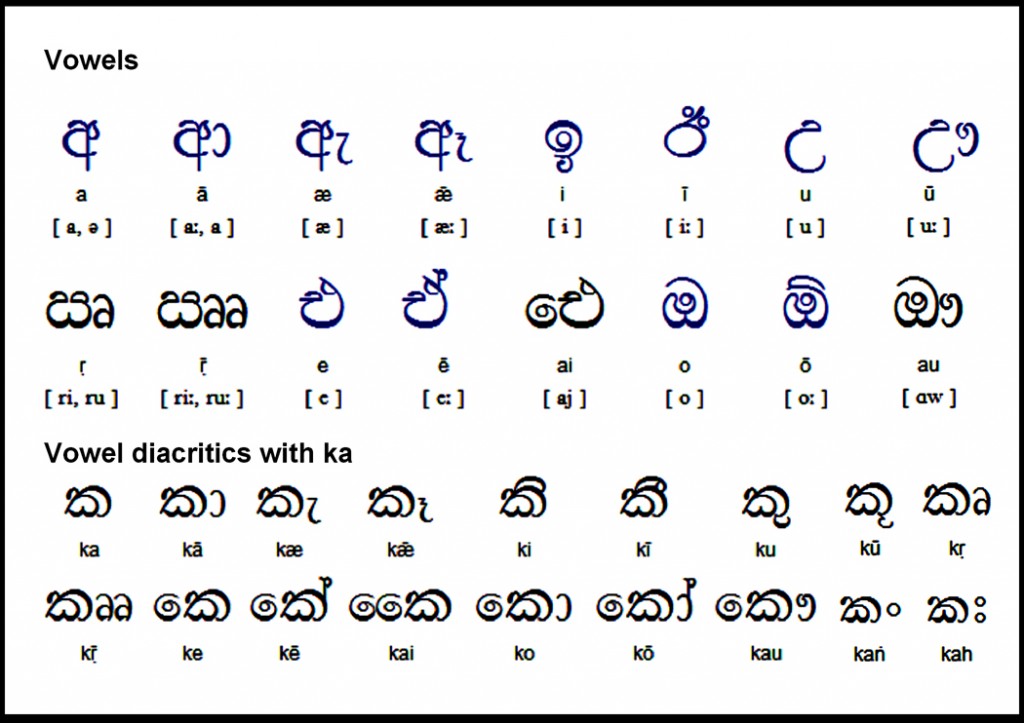
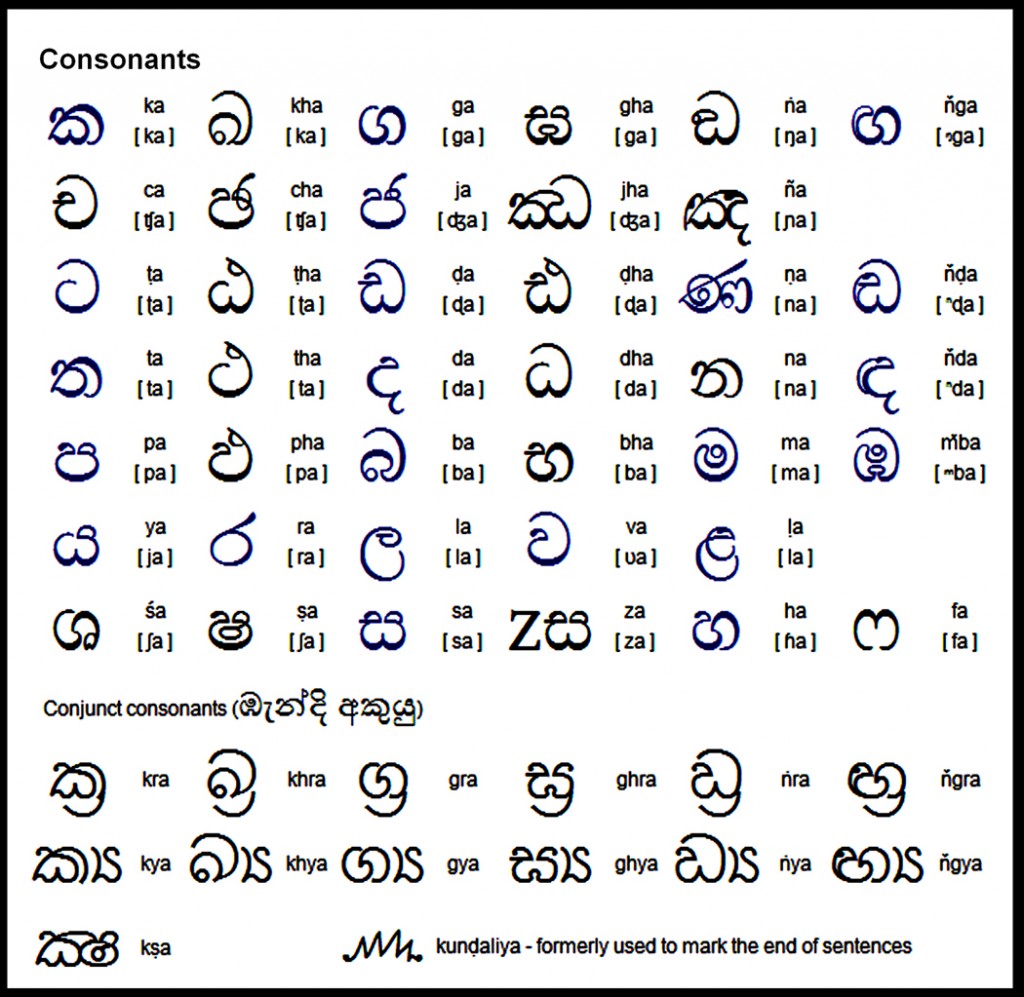
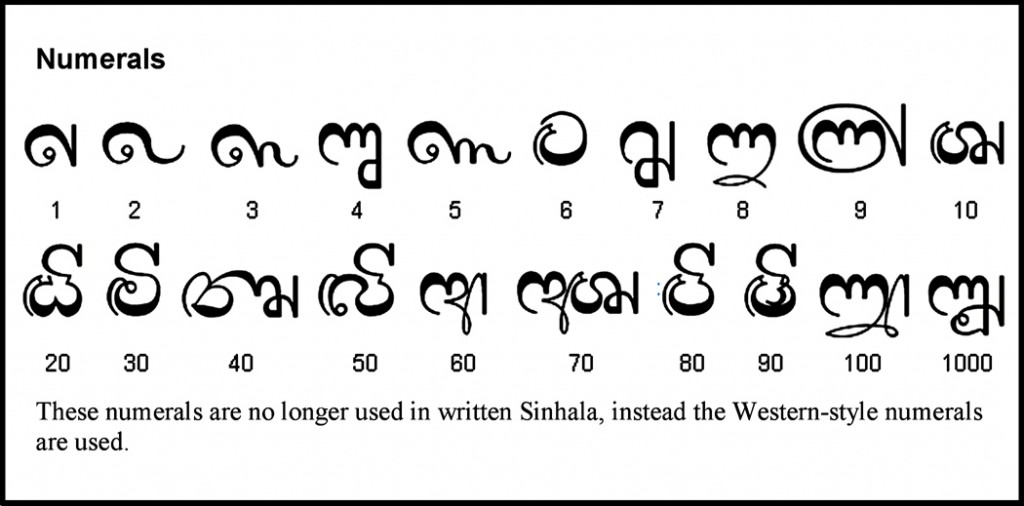
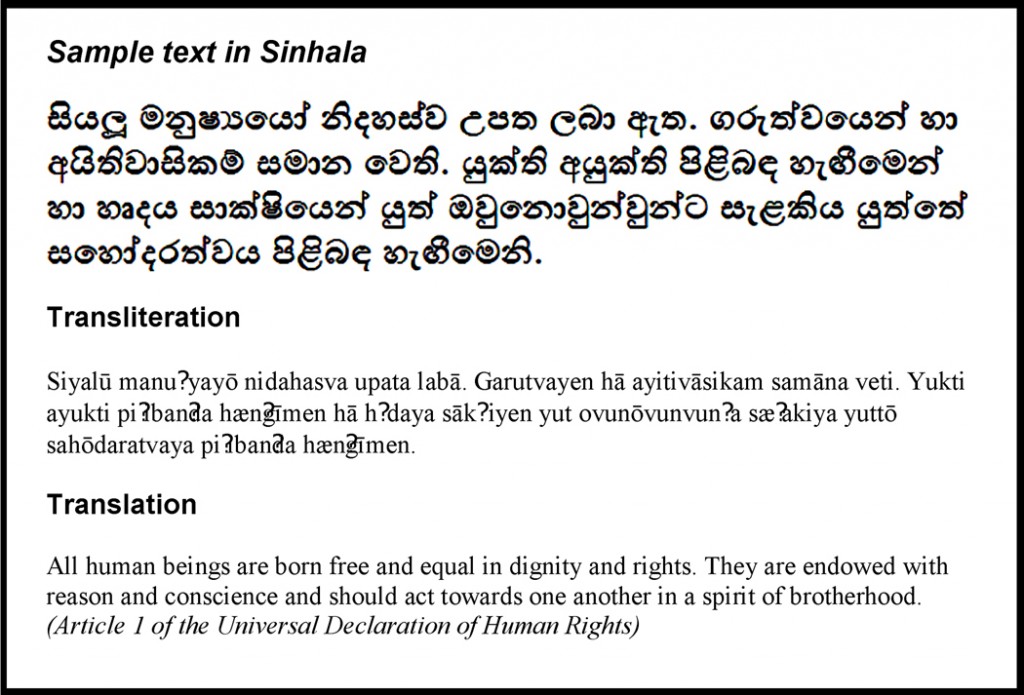 Link to Google search for Sinhalese language:
Link to Google search for Sinhalese language:
Sinhalese people
From Wikipedia, the free encyclopedia
|
Sinhalese |
|
|
|
|
|
Total population |
|
|
Greater than 15 Million |
|
|
Regions with significant populations |
|
|
~100,000 (2010)[2] |
|
|
29,055 (2008)[3] |
|
|
68,738 (2008)[4] |
|
|
19,830 (2006)[5] |
|
|
13,890 (2006)[6] |
|
|
12,000 (1993)[7] |
|
|
10,000 (2009)[8] |
|
|
7,257 (2006)[9] |
|
|
Languages |
|
|
Religion |
|
|
Theravada Buddhist majority • Christian |
|
|
Related ethnic groups |
|
|
Sri Lankan people, Indo-Aryans, Bengali people, Vedda people, Rodiya people, Tamil people |
|
The Sinhalese (Sinhala:????? ????? Sinhala Jathiya) are an ethnic group native to the island of Sri Lanka.[12] They constitute 74.9% of the Sri Lankan population and number greater than 15 million.[1] The Sinhalese identity is based on language, historical heritage and religion. The Sinhalese speak Sinhala, an Indo-Aryan language, and are predominantly Theravada Buddhists,[13] although a small percentage of Sinhalese follow branches of Christianity. The Sinhalese are mostly found in North central, Central, South, and West Sri Lanka. According to legend Mahavamsa they are the descendants of the exiled Prince Vijaya who arrived from East India to Sri Lanka in 543 BCE.But the popular Sinhalese folklore and some references in Mahavamsa to times before Vijaya, indicate the Sinhalese are actually descendants of earlier inhabitants of Sri Lanka; (Raksha, Yaksha, Deva and Naga) who intermixed with Vijaya and the other Aryan invaders from India.[14]
Etymology
The Sinhalese are also known as “Hela” or “Sinhala”. These synonyms find their origins in the two words Sinha (meaning “lion”) and Hela (meaning “pristine”). The name Sinhala translates to “lion people” and refers to the myths regarding the descent of the legendary founder of the Sinhalese people, the prince Vijaya. The royal dynasty from ancient times on the island was the Sinha (Lion) royal dynasty and the word Sinha finds its origins here.Sri Lanka has got its old name “Sinhale” or “Heladiva” after Sinhalese who built up the civilization of the island.The former names of the country “Serendib” ,”Seylan” and “Ceylon” have derived from the old name “Sinhale”
Another clarification for origin of Sinhala is from siw (four) Hela (Pristine). Raksha, Yaksha, Deva, Naga were the four powerful hela tribes.[15]
History
See also: History of Sri Lanka, Dipavamsa, Mahavamsa and Culavamsa
Ancient history
The genesis myth and early recorded history of the Sinhalese is chronicled in two documents, the Mahavamsa, written in P?li around the 4th century CE, and the much later Chulavamsa (probably penned in the 13th century CE by the Buddhist monk Dhammakitti). These are ancient sources which cover the histories of the powerful ancient Sinhalese kingdoms of Anuradhapura and Polonnaruwa which lasted for 1500 years. The Mahavansa describes the existence of fields of rice and reservoirs, indicating a well-developed agrarian society. The folklore of the Sinhalese people also speaks of many royal dynasties prior to the Sinha royal dynasty: Manu, Tharaka, Mahabali, Raavana, etc.as per the oldest Indian epic poemRamayan and consists many places in relation to this story such as Adam’s Bridge (Rama Setu),Sita eliya and falls(where Princes Sita stayed and bathed)Ravana Falls (where King Ravana Bathed and enjoyed),[citation needed]
Left- A section of the mural at Ajanta in Cave No 17,depicts the ‘coming of Sinhala’.The prince (Prince Vijaya) is seen in both of groups of elephants and riders.
Right-The consecration of King Sinhala (Prince Vijaya) (Detail from the Ajanta Mural of Cave No 17).
According to the Mahavamsa, the Sinhalese are descended from the exiled Prince Vijaya and his party of seven hundred followers who arrived on the island in 543 BCE. Vijaya and his followers were said to have arrived in Sri Lanka after being exiled from the city of Sinhapura in West Bengal, East India.[16] Buddhism is then said to have been introduced to the Sinhalese from India by Mahinda, son of the Mauryan Emperor Ashoka the Great, during the 3rd century BCE.
Medieval history
See also: Medieval history of Sri Lanka
During the middle ages Sri Lanka was well known for its agricultural prosperity under the Parakramabahu in Polonnaruwa during which period the island was famous around the world as the rice mill of the east. Later in the 13th century the country’s administrative provinces were divided into three independent kingdoms: Kingdom of Sitawaka, Kingdom of Kotte and the Kandyan kingdom.[17] The invasion by Magha in the 13th century led to migrations by the Sinhalese to areas not under his control. This migration was followed by a period of conflict among the Sinhalese chiefs who tried to exert political supremacy. Parakramabahu VI in the 15th century was the only Sinhalese king during this time who could bring back the unity of the whole island. Trade also increased during this period, as Sri Lanka began to trade Cinammon and a large number of Muslim traders were bought into the island.[18]
In the 15th century a Kandyan Kingdom formed which divided the Sinhalese politically into low-country and up-country.[18]
Modern history
|
Historical population |
||
|
Year |
Pop. |
±% |
|
1881 |
1,846,600 |
— |
|
1891 |
2,041,200 |
+10.5% |
|
1901 |
2,330,800 |
+14.2% |
|
1911 |
2,715,500 |
+16.5% |
|
1921 |
3,016,200 |
+11.1% |
|
1931 |
3,473,000 |
+15.1% |
|
1946 |
4,620,500 |
+33.0% |
|
1953 |
5,616,700 |
+21.6% |
|
1963 |
7,512,900 |
+33.8% |
|
1971 |
9,131,300 |
+21.5% |
|
1981 |
10,979,400 |
+20.2% |
|
1989 (est.) |
12,437,000 |
+13.3% |
|
2001 |
13,876,200 |
+11.6% |
|
2011 |
15,173,820 |
+9.4% |
|
2001 Census was only carried out in 18 of the 25 districts. Source:Department of Census |
||
The Sinhalese have a stable birth rate and a population that has been growing at a slow pace relative to India and other Asian countries.
Culture
Main article: Culture of Sri Lanka
Sinhalese culture is a unique one dating as far back as 2600 years and has been nourished by Theravada Buddhism. Its main domains are sculpture, fine arts, literature, dancing, poetry and a wide variety of folk beliefs and rituals traditionally. Ancient Sinhalese stone sculpture and inscriptions are known worldwide and is a main foreign attraction in modern tourism. Sigirirya is famous for its frescoes. Folk poems were sung by workers to accompany their work and narrate the story of their lives. Ideally these poems consisted of four lines and, in the composition of these poems, special attention had been paid to the rhyming patterns. Buddhist festivals are dotted by unique music using traditionally Sinhala instruments. More ancient rituals like tovils (devil exorcism) continue to enthrall audiences today and often praised and admired the good and the power of Buddha and gods in order to exorcise the demons.
Concerning popular music, Ananda Samarakoon developed the reflective and poignant Sarala gee style with his work in the late 1930s/early 1940s. He has been followed by artists of repute such as Sunil Shantha, W. D. Amaradeva, Premasiri Khemadasa, Nanda Malini, Victor Ratnayake, Austin Munasinghe, T. M. Jayaratne, Sanath Nandasiri, Sunil Edirisinghe, Neela Wickremasinghe, Gunadasa Kapuge, Malini Bulathsinghala and Edward Jayakody.
Dramatist Professor Ediriweera Sarachchandra revitalized the drama form with Maname in 1956. The same year, film director Lester James Peries created the artistic masterwork Rekava which sought to create a uniquely Sinhala cinema with artistic integrity. Since then, Peries and other directors like Vasantha Obeysekera, Dharmasena Pathiraja, Mahagama Sekera, W. A. B. de Silva,Dharmasiri Bandaranayake, Professor Sunil Ariyaratne, Siri Gunasinghe, G. D. L. Perera, Piyasiri Gunaratne, Titus Thotawatte, D. B. Nihalsinghe, Ranjith Lal, Dayananda Gunawardena, Mudalinayake Somaratne, Ashoka Handagama, and Prasanna Vithanage have developed an artistic Sinhala cinema. Sinhala cinema is often made colorful by the incorporation of songs and dance adding more uniqueness to the industry.
The Sinhalese speak Sinhala, also known as “Helabasa”; this language has two varieties, spoken and written. Sinhala is an Indo-Aryan language[13] brought to Sri Lanka by northeast Indians who settled on the island in the 6th century BCE.[20][21] Sinhala developed in a way different from the other Indo-Aryan languages because of the geographic separation from its Indo-Aryan sister languages. Sinhala was influenced by many languages, prominently Pali, the sacred language of Southern Buddhism, and Sanskrit. Many early Sinhala texts such as the Hela Atuwa were lost after their translation into Pali. Other significant Sinhala texts include Am?vatura, Kavu Silumina, Jathaka Potha and Sala Liheeniya. Sinhala has also borrowed words from other Indian languages and the colonial languages Portuguese, Dutch, and English.[22]
Literature
Main articles: Sri Lankan literature and Sinhalese literature
Sandesha Kavyas written by Buddhist priests of Sri Lanka are regarded as some of the most sophisticated and versatile works of literature in the world. The Sinhala language was mainly inspired by Sanskrit and Pali, and many words of the Sinhala language derive from these languages. Today some English words too have come in as a result of the British occupation during colonial times, and the exposure to foreign cultures through television and Hollywood movies. Additionally many Dutch and Portuguese words can be seen in the coastal areas.
Folk tales like Mahadana Muttha saha Golayo and Kawate Andare continue to entertain children today. Mahadana Muttha tells the tale of a fool cum Pundit who travels around the country with his followers (Golayo) creating mischief through his ignorance. Kawate Andare tells the tale of a witty court jester and his interactions with the royal court and his son.
In the modern period, Sinhala writers such as Martin Wickremasinghe and G. B. Senanayake have drawn widespread acclaim. Other writers of repute include Mahagama Sekera and Madewela S. Ratnayake. Martin Wickramasinghe wrote the immensely popular children’s novel Madol Duwa. Munadasa Cumaratunga’s Hath Pana is also widely known.
Religion
Main articles: Buddhism in Sri Lanka and Christianity in Sri Lanka
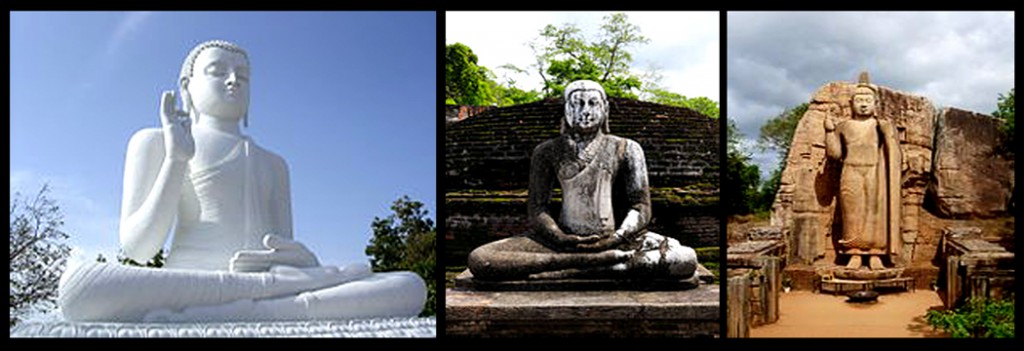 Left-The Buddha statue at Mihintale.
Left-The Buddha statue at Mihintale.
Center-A Buddhist statue in the ancient capital city of Polonnaruwa, 12th century
Right-Avukana Buddha statue, a 12m standing Buddha statue belongs to the reign of Dhatusena, 5th century AD
The form of Buddhism in Sri Lanka is known as Theravada (school of elders). The Pali chronicles claim (e.g., The Mahavansa) that the Sinhalese as an ethnic group are destined to preserve and protect Buddhism. In 1988 almost 93% of the Sinhalese speaking population in Sri Lanka were Buddhist.[23] Observations of current religious beliefs and practices demonstrate that Sinhalese as a religious community have complex worldview as Buddhists. Due to the proximity and on some occasions similarity of certain doctrines, there are many areas where Buddhists and Hindus share religious views and practices. This can lead to the opinion that Buddhists have adopted religious elements from Hindu traditions in their religious practices. Some of these practices may relate to ancient indigenous beliefs and traditions on spirits, worship of deities and godlings and some figures appear to demons. Some of these demonic figures are used in healing rituals and may be native to the island.[22][24][25]
Prominent Sri Lankan anthropologists Gananath Obeyesekere and Kitsiri Malalgoda used the term “Protestant Buddhism” to describe a type of Buddhism that appeared among the Sinhalese in Sri Lanka as a response to Protestant Christian missionaries and their evangelical activities during the British colonial period. This kind of Buddhism involved emulating the Protestant strategies of organizing religious practices. They saw the need to establish Buddhist schools for educating Buddhist youth and organizing Buddhists with new organizations such as the Young Men’s Buddhist Association, as well as printing pamphlets to encourage people to participate in debates and religious controversies to defend Buddhism.[26]
There is a significant Sinhalese Christian community, in the maritime provinces of Sri Lanka.[22] Christianity was brought to the Sinhalese by Portuguese, Dutch, and British missionary groups during their respective periods of rule.[27] Sinhalese Christians mainly follow Roman Catholicism, followed by Protestantism.[23] Their cultural centre is Negombo.
Religion is considered very important among the Sinhalese. According to a 2008 Gallup poll, 99% of Sri Lankans considered religion an important aspect of their daily lives.[28]
Sinhalese girl in Osaria and a Sinhalese man in National dress.
Traditionally during recreation the Sinhalese wear a sarong (sarama in Sinhala). Men may wear a long-sleeved shirt with the sarong, while women wear a tight-fitting, short-sleeved jacket with a wrap-around called the cheeththaya. In the more populated areas, Sinhalese men also wear Western-style clothing — wearing suits while the women wear skirts and blouses. For formal and ceremonial occasions women wear the traditional Kandyan (Osaria) style, which consists of a full blouse which covers the midriff completely, and is partially tucked in at the front. However, modern intermingling of styles has led to most wearers baring the midriff. The Kandyan style is considered as the national dress of Sinhalese women. In many occasions and functions, even the saree plays an important role in women’s clothing and has become the de facto clothing for female office workers especially in government sector. An example of its use is the uniform of air hostesses of Sri Lankan Airlines.[22]
Cuisine
Main article: Sinhalese cuisine
Kiribath with lunumiris
Sinhalese cuisine is one of the most complex cuisines of South Asia. Due to its proximity to South India, the cuisine of Sinhalese shows some influence, yet is in many ways quite distinct. As a major trade hub, it draws influence from colonial powers that were involved in Sri Lanka and by foreign traders. Rice, which is consumed daily, can be found at any occasion, while spicy curries are favorite dishes for lunch and dinner.[29] Some of the Sri Lankan dishes have striking resemblance to Kerala cuisine, which could be due to the similar geographic and agricultural features with Kerala. A well-known rice dish with Sinhalese is Kiribath, meaning “Milk Rice.” In addition to sambols, Sinhalese eat “Mallung”, chopped leaves mixed with grated coconut and red onions. coconut milk is found in most Sri Lankan dishes to give the cuisine its unique flavor.
Visual art and architecture
Developed upon Indo-Aryan architectural skills in the late 6th century BCE Sinhalese people who lived upon greater kingdoms such as Anuradhapura and Polonnaruwa have built so many architectural examples such as Ruwanwelisaya, Jetavanaramaya – second tallest brick building in the ancient world after Pyramid of Giza, and Abayagiriya – third tallest brick building in the ancient world. And also with the ancient hydrolic technology which is also unique to Sinhalese people to build ancient tanks, systamatic ponds with fountains moats and Irrigational reservoirs such as Parakrama Samudra, Kawdulla and Kandalama. Sigirya which consider as the 8th wonder of the world is a combination of natural and man made fortress, which consists so many architectural aspects.
Performing arts
Performing arts of the Sinhalese people can be catogarized into few subsections.
- Up-country (Udarata) performing arts (Music and Dances) consist of 18 Wannam (dance routines) featuring behaviours of various animals such as elephant,eagle,cobra,monkey,peacock and rabbit,mainly performing in Annual Perahara pegent in Sri Dalada Maligawa Kandy.
- Down-county (Pahatharata) performing arts (Music and Dances) have significant dancing style which is using for cure illnesses and spiritual clarification.the main feature in this dances is dancer wear on Masks representing various Gods and Demons.and use elements such as fire and water to bless people.
- Sabaragamuwa performing arts (Music and Dances) have also a significant dancing style mainly to entertain people.
- Folk Music and Dances differ accroding to the casts of Sinhalese people and also some times in regional wise – mainly popular among small children,specially girls.These arts are widely performing during Sinhalese New year period.
Martial arts
Main article: Sinhalese martial arts
Angampora is the traditional martial art of Sinhalese. It combines combat techniques, self-defense, sport, exercise and meditation.[30] Key techniques observed in Angampora are: Angam, which incorporates hand-to-hand fighting, and Illangam, which uses indigenous weapons such as Velayudaya, staves, knives and swords. Its most distinct feature is the use of pressure point attacks to inflict pain or permanently paralyze the opponent. Fighters usually make use of both striking and grappling techniques, and fight until the opponent is caught in a submission lock that they cannot escape. Usage of weapons is discretionary. Perimeters of fighting are defined in advance, and in some of the cases is a pit.[31][32] Angampora became nearly extinct after the country came under British rule in 1815, but survived in a few families until the country regained the independence.[33]
Sinhala Medicine
It is believed that the Sinhala Medicine started in the Era of Great Hela King Ravana.King Ravana was an Emperor ruled in Sri Lanka. Traditional Sinhalese villages in early days had at least one chief Medical personnel called Weda Mahaththaya (Doctor).These people practice their clinical activities by inheritance.The Sinhala Medicine resembles some of Ayurvedic practices in contrast for some treatments they use Buddhist Chantings (Pirith) in order to strengthen the effectiveness.
According to the Mahavamsa, the ancient chronicle of Sinhalese royalty, written in the sixth century A.D.,King Pandukabhaya of Sri Lanka (reigned 437 BC to 367 BC) had lying-in-homes and Ayurvedic hospitals (Sivikasotthi-Sala) built in various parts of the country. This is the earliest documentary evidence we have of institutions specifically dedicated to the care of the sick anywhere in the world.[34][35] Mihintale Hospital is the oldest in the world.[36]
Education
Main article: Education in Sri Lanka
The Sinhalese have a long history of literacy and formal learning. Instruction in basic fields like writing and reading by Buddhist Monks pre-date the birth of Christ. This traditional system followed religious rule and was meant to foster Buddhist understanding. Training of officials in such skills as keeping track of revenue and other records for administrative purposes occurred under this institution.[37]
Technical education such as the building of reservoirs and canals was passed down from generation to generation through home training and outside craft apprenticeships.[37]
The arrival of the Portuguese and Dutch and the subsequent colonization maintained religion as the center of education though in certain communities under Catholic and Presbyterian hierarchy. The British in the 1800s initially followed the same course. Following 1870 however they began a campaign for better education facilities in the region. Christian missionary groups were at the forefront of this development contributing to a high literacy among Christians.[37]
By 1901 schools in the South and the North were well tended. The inner regions lagged behind however. Also, English education facilities presented hurdles for the general populace through fees and lack of access.[37]
Outside Sri Lanka
Main article: Sri Lankan diaspora
As with many of the people from former colonies, Sinhalese have emigrated to several countries. There are small communities in the UK, Australia, United States and Canada with Sinhalese ancestry. In addition to this there are many Sinhalese, who reside in the above mentioned countries and countries in the Middle East, Southeast Asia and Europe, temporarily in connection with employment and education. They are often employed as guest workers in the Middle East and professionals in the other regions.
Australia
People of Sinhalese ancestry as a percentage of the population in Sydney, Australia divided geographically by postal area, as of the 2011 census.
Main article: Sri Lankan Australian
The 2006 Census in Australia found that there were approximately 29,055 Sinhalese Australians (0.1 percent of the population). That was an addition of 8,395 Sinhalese Australians (a 40.6 percent increase) from the 2001 Census. There are 73,849 Australians (0.4 of the population) who reported having Sinhalese ancestry in 2006. This was 26 percent more in 2001, in which 58,602 Australia reported having Sinhalese ancestry. The census is counted by Sri Lankans who speak the Sinhalese language at home.
Census data released by the Australian Bureau of Statistics in 2004 reported that Sinhalese Australians are by religion 29.7 percent Catholic; 8.0 percent Anglican, 9.9 percent other Christian; 46.9 percent “Other Religions” (mainly Buddhist), and 5.5 percent no religion. The Sinhalese language was also reported to be the 29th-fastest-growing language in Australia (ranking above Somali but behind Hindi and Belarusian).
Sinhalese Australians have an exceptionally low rate of return migration to Sri Lanka. In December 2001, the Department of Foreign Affairs estimated that there were 800 Australian citizens resident in Sri Lanka. It is unclear whether these were returning Sri Lankan emigrants with Australian citizenship, their Sri Lankan Australian children, or other Australians present on business or for some other reason.
Canada
Main article: Sri Lankan Canadians
In the 2001 Canadian census, 10,000 people identified themselves as of Sinhalese ancestry, out of 62,000 Sri Lankans.
India
Main article: Sri Lankans in India
There are a small amount of Sinhalese people in India, scattered all around the country, but mainly living in and around the northern and southern regions. Delhi has the largest concentration of Sinhalese people with 1,100, the states of Tamil Nadu, Maharashtra have 800 and 400 respectively. The Andaman and Nicobar Islands and the state of Gujarat have 200 each while other states such as Andhra Pradesh, Kerala, Karnataka, West Bengal, Jharkhand have populations ranging from 60 to 30 people.[39]
Italy
Main article: Sri Lankans in Italy
It is estimated that there are 30,000-33,000 Sinhalese in Italy. The major Sinhalese communities in Italy are located in Lombardia (In the districts Loreto and Lazzaretto), Milan, Lazio, Rome, Naples, and Southern Italy (Particularly Palermo, Messina and Catania). But they have also opened businesses such as restaurants, cleaning enterprises (e.g., Cooperativa Multietnica di Pulizie Sud-Est), call centres, video-shops, traditional food shops, and minimarkets.[40]
Many Sinhalese have migrated to Italy since the 1970s. Italy was attractive to the Sinhalese due to perceived easier employment opportunities and entry, compared to other European countries.[40]
In the late 1970s, Sinhalese Catholic women migrated to Italy to work in elderly homes. This was followed by a wave of Sinhalese migrants who worked for Italian entrepreneurs in the early 1980s. Italy was often seen as a temporary destination, but many Sinhalese decided to settle there. Many Sinhalese have also migrated to Italy, mainly through the Balkans and Austria.[40]
Admission acts also encouraged more Sinhalese to migrate to Italy. For example, the Dini Decree in 1996 made it easier for Sinhalese workers to bring their families to Italy. In Rome, Naples, and Milan, the Sinhalese have built up “enlarged families”, where jobs are exchanged among relatives and compatriots.[40]
The major organisation representing the Sinhalese in Italy is the Sri Lanka Association Italy.[40]
New Zealand
Main article: Sri Lankan New Zealander
The early arrivals to come to New Zealand from what was then British Ceylon were a few prospectors attracted to the gold rushes. By 1874, there were 33 New Zealand residents born in Ceylon.
After 1950 under the Colombo Plan, some students and trainees received education in New Zealand. Up until the late 1960s, the number of New Zealand residents born in Ceylon remained static. As a demand for skilled professionals in New Zealand grew, it led to a noticeable increase in the number of immigrants about this time. Racial and economic tensions in Dominion of Ceylon, made worse after the declaration of the republic in 1972, also swelled immigrant numbers.[41]
In 1983, the Sri Lankan Civil War began with Sinhalese political dominance being challenged by the militant Tamil Tigers, who sought a separate Tamil state within Sri Lanka.[41] After the 1983 riots in Sri Lanka ushered in an extended civil war, many Sri Lankans, both Tamil and Sinhalese, fled Sri Lanka, the number of arrivals from Sri Lanka to New Zealand and the Sri Lankan-born population in New Zealand rose dramatically.[42]
The numbers arriving continued to increase, and at the 2006 census there were over 7,000 Sri Lankans living in New Zealand.[41]
Sri Lankan New Zealanders comprised 3% of the Asian population of New Zealand in 2001. Out of the Asians, the Sri Lankans were the most likely to hold a formal qualification and to work in white-collar occupations. Sri Lankans mainly worked in health professions, business and property services, and the retail and manufacturing sectors, in large numbers. Most lived in Auckland and Wellington, with smaller populations in Waikato, Manawatu, Canterbury and others.[43]
United Kingdom
Main article: Sri Lankans in the United Kingdom
Now there are many Sri Lankan associations in the United Kingdom. The Sinhalese community is well represented by many old boys associations of prominent schools in Sri Lanka and many temple organizations associated with Buddhist and Hindu temples represent both Sinhala and Tamil communities in the UK. Though Sinhala people in particular and Sri Lankans in general have migrated to the UK over the centuries beginning from the colonial times, the number of Sinhalese people in the UK cannot be estimated accurately due to inadequacies of census in the UK. The UK government does not record statistics on the basis of language or ethnicity and all Sri Lankans are classified into one group as Asian British or Asian Other.
The Sinhalese have not neglected the use of Sinhala language in the UK. For the Sinhala readers, the newspaper Lanka Viththi (Information on Lanka) was created in 1997 to provide Sinhala reading materials for the Sinhalese UK community. This particular monthly newspaper, the first of its kind outside Sri Lanka, celebrates its successful survival in abroad. Available:[44]
In 2006, a Sinhala TV channel called Kesara TV[45] was set up in London to provide the Sinhala-speaking people of the UK a TV channel in Sinhala.[46]
. This development in entertainment industry had a short life which resulted in the dissolving of the company in 2009.[45]
Some of the Sinhalese community have been against the public display of support for the LTTE in the 2009 Tamil Diaspora protests in Westminster, London.[47] Some of the Sinhalese community in the UK have faced violence from some British Sri Lankan Tamils over the ethnic conflict in the Sri Lankan Civil War. Several Sinhala-owned fried chicken shops in North London and a Sinhalese Buddhist temple in Kingsbury were vandalised in 2009.[48]
United States
Main article: Sri Lankan American
The Sinhalese number about 12,000 in the USA.[49] The New York City Metropolitan Area contains the largest Sri Lankan community in the United States, receiving the highest legal permanent resident Sri Lankan immigrant population,[50] followed by Central New Jersey and the Los Angeles metropolitan area.
Genetic studies
See also: Genetic studies on Sinhalese
Genetic distance of Sinhalese to other ethnic groups in the Indian Subcontinent according to an Alu Polymorphism analysis.
Studies looking at the origin of the Sinhalese have been contradictory. Older studies suggest a predominantly Sri Lankan Tamil contribution followed by a significant Bengali contribution with no North Western Indian contribution,[51][52] while more modern studies point towards a predominantly Bengali contribution and a minor Tamil and North Western Indian (Gujarati & Punjabi) contribution.[53][54][55] Multiple studies have found no significant genetic difference between the Sinhalese and the three other major ethnic groups in Sri Lanka (Sri Lankan Tamil, Indian Tamil and Sri Lankan Moor).[52][56][57][58][59][60]
It is debatable whether the Sri Lankan population have genetic links to Far East Asian populations however due to their close links to North East India, there is a likelihood of some traces of East Asian genes.[61][62][63]
This page was last modified on 5 May 2014 at 23:22
Sinhalese People and Cultures
Please visit the following links for more information about Sinhalese:
https://www.google.com/#q=sri+lanka
Frescoes on the Sigiriya rock fortress in Matale District, 5th century.
Right-View of Sri Lanka from the Space Shuttle.
Please visit the following link for more information about Google, Sri Lanka map:
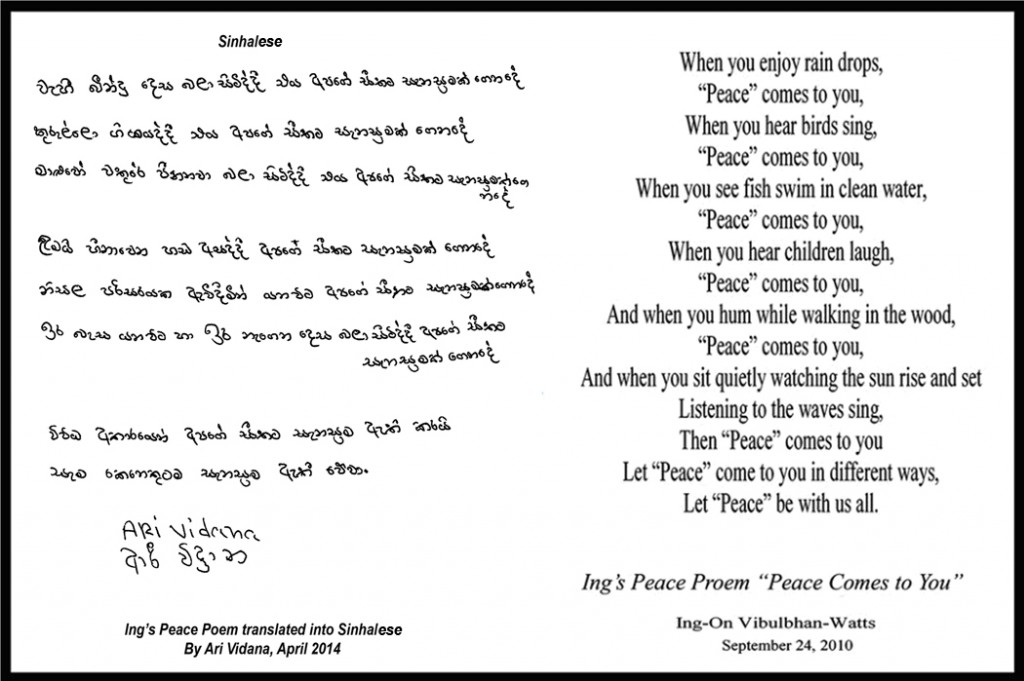

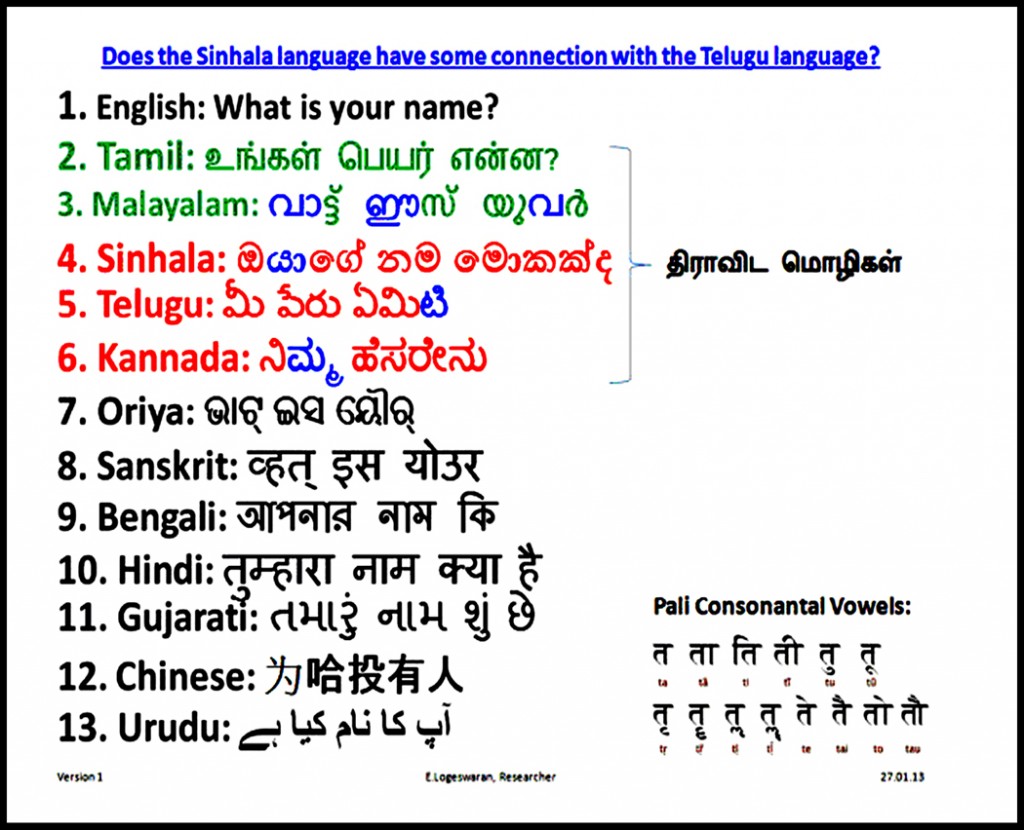





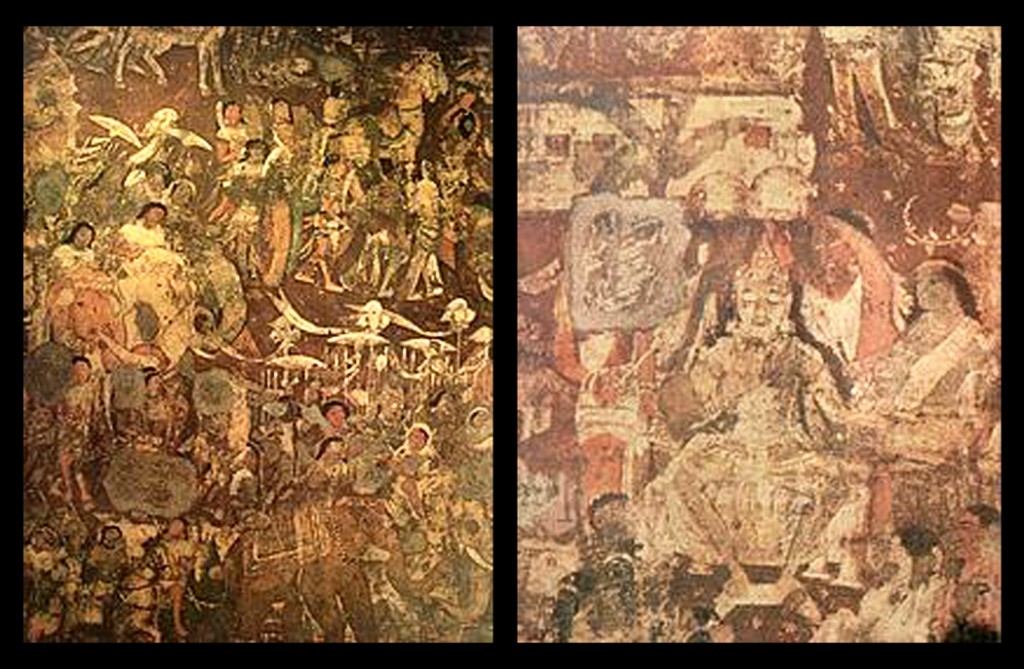
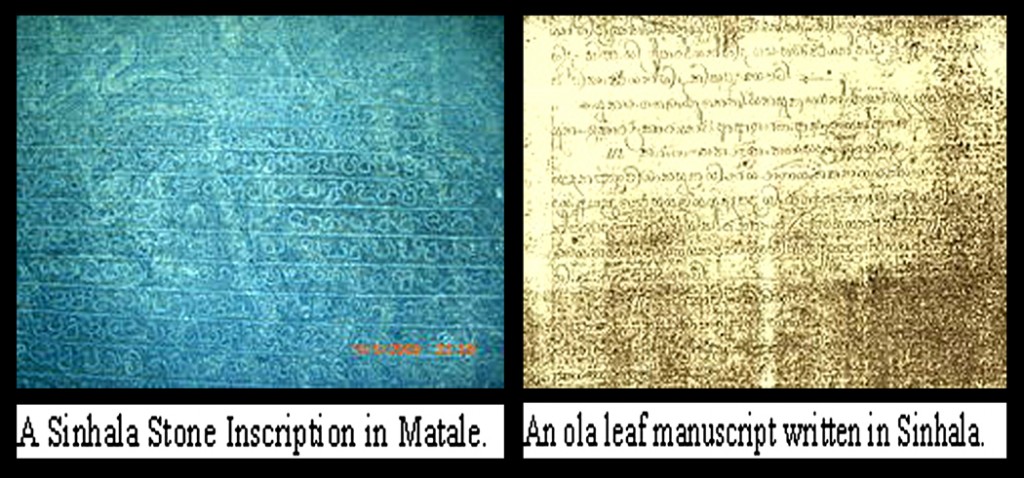
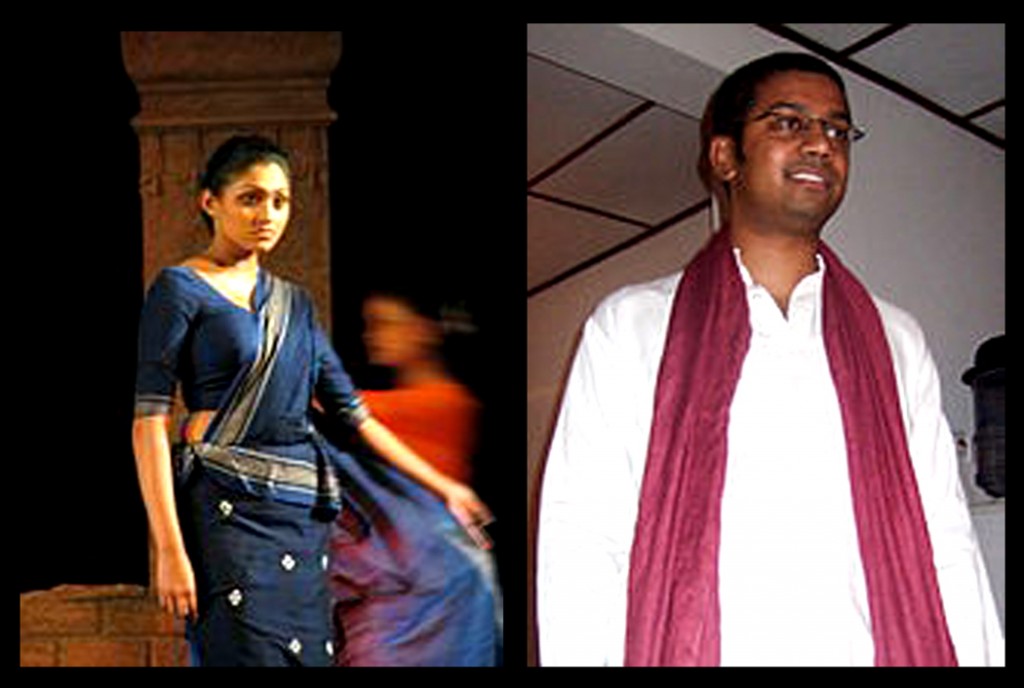
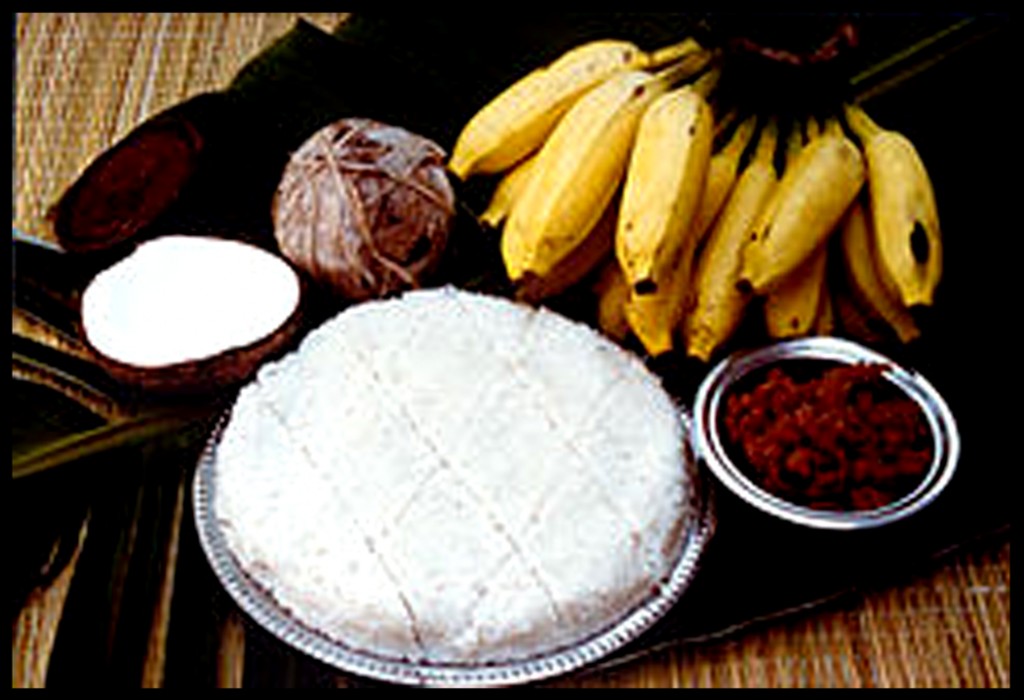



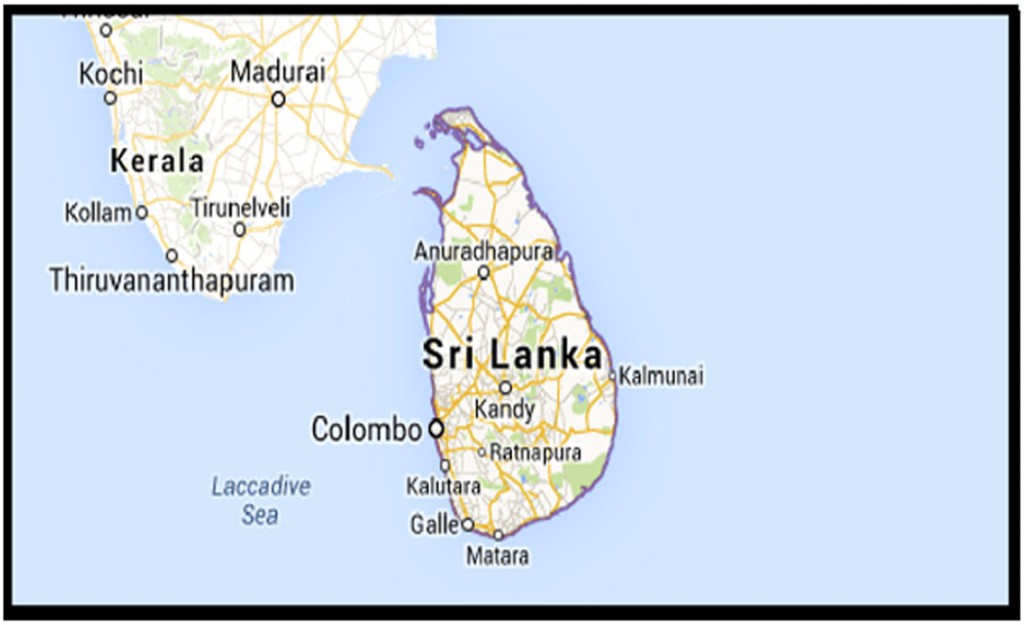
Leave a Reply